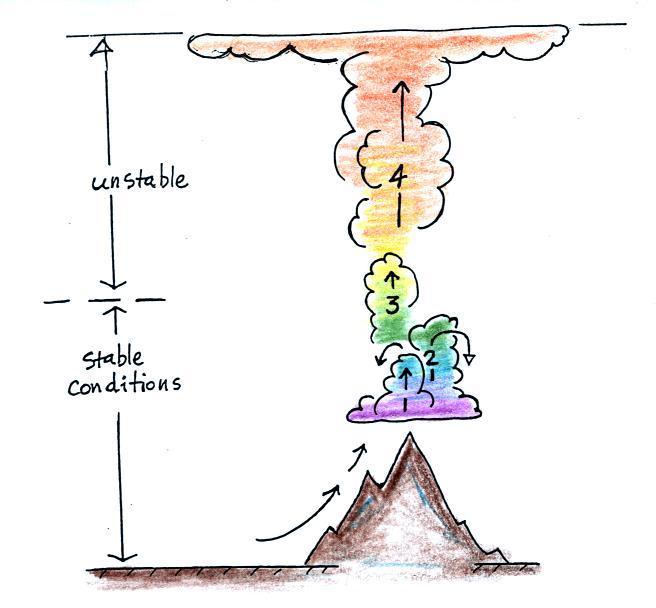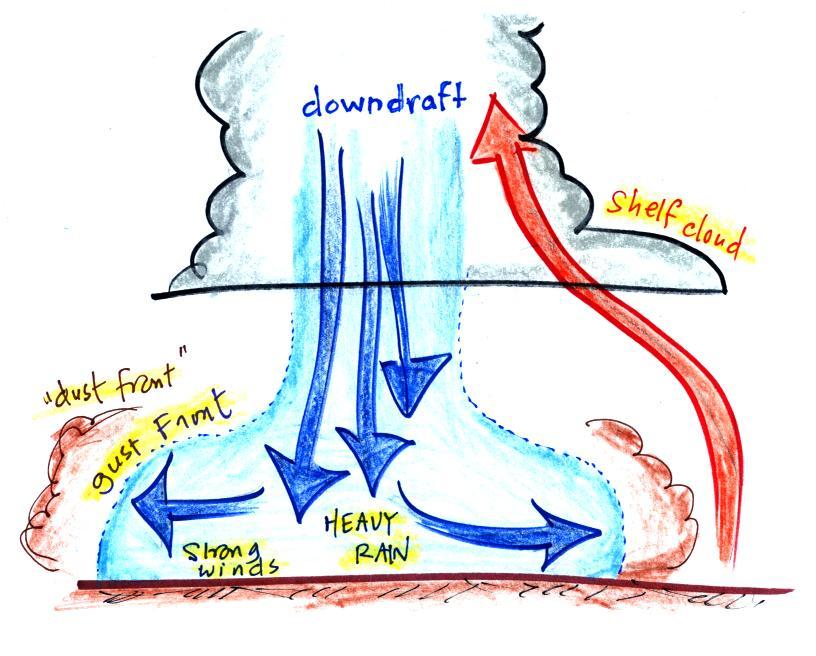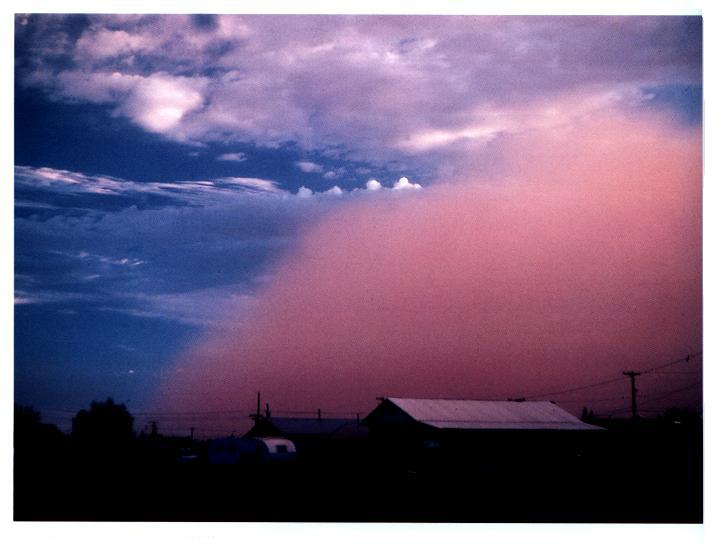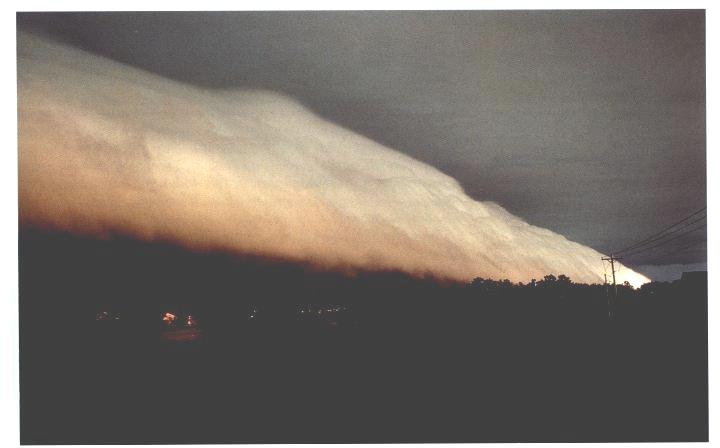
Here's a view
of the surface features found between 30 S and 30 N latitude from
above. This is the material you should become familiar with
before next week's quiz. Here's a link to the satellite
photograph that I showed in class. To show the
whole globe images from several weather satellites are blended
together. You can usually see the ITCZ pretty clearly on the
satellite photo, it is the band of clouds found near the center of the
picture. Clouds are mostly absent to the north and south of the
ITCZ. This is the region of the subtropical highs, the sinking
air keeps clouds from forming.
Here's a sketch of surface features
found from about 15 N to 75 N laitude. We didn't cover this
in class but I'll insert it here anyways. Other than the
prevailing westerlies you don't need to worry about these high latitude
features for the quiz.
Winds
blowing north from H
pressure at 30 N toward Low pressure at 60 N turn to the right and blow
from the SW. These are the "prevailing westerlies."
The polar easterlies are cold winds coming down from high pressure at
the north pole. The subpolar low pressure belt is found at 60
latitude. This
is also a convergence zone where the cold polar easterly winds and the
warmer prevailing westerly winds meet. Because the air masses
south and north of 60 latitude are so different, the boundary between
these
two different kinds of air is called the polar front and is often drawn
as a stationary front on weather maps. A strong current of winds
called the polar jet stream is found overhead. Strong middle
latitude storms will often form along the polar front.
The 3-cell model
assumes that the earth is of uniform composition and not tilted toward
or away from the sun. It predicts belts of high pressure at 30 N
and 30 S latitude as shown above at left. Because the
real world
has oceans and continents we find centers of high pressure, not
belts, located
near 30 latitude. They move north and south of 30 degrees during
the year as the N. Pole tilts toward and away from the sun.
The following picture might show this more clearly (this was on a
class handout distributed in class)

The high pressure center found off
the west coast of the US is called the Pacific High. The Bermuda
High is found off the east coast. Don't worry about the names of
the high pressure centers found in the southern hemisphere.
Winds blowing around these centers of high
pressure create some of the world's major ocean currents.
The California current is a cold southward
flowing current found off the west coast of the US. The Gulf
Stream is the warm northward flowing current along the east
coast.
The 3-cell model
predicts a belt of low pressure near 60 latitude. In the real
world we
find centers of low pressure: the Aleutian Low off the west coast of
Canada and the Icelandic Low off the east coast. These weren't
mentioned in class. A true belt of low pressure is found near 60
latitude in the southern hemisphere. This is because that part of
the globe is mostly just ocean
The figure above shows the intertropical convergence zone (colored
pink) south of the Equator. This happens during the
northern hemisphere winter. The ITCZ and the other features move
northward in summer. This can be seen by comparing the figure
above with the one below.
The movement of the Pacific High north and south of its
nominal position near 30 degrees latitude is part of what causes our
summer monsoon in Arizona.

In the
winter the Pacific High is found south of 30 N latitude.
Winds to the north of the high blow from the west. Air
originating over the Pacific Ocean is moist (though the coastal water
is cold so this air isn't as moist as it would be if it came off warmer
water). Before reaching Arizona the air must travel over high
mountains in California. The air loses much of
its moisture as it
does this (remember the rain shadow
effect). The air is pretty dry by the time it reaches
Arizona. Significant winter rains occur in Arizona when storms
systems are able to draw moist subtropical air from the southwest
Pacific ocean into
Arizona.
During the summer, the Pacific
High moves north of 30 N
latitude. Winds on the southhern side of the subtropical high
have an easterly component. Moist air originating in Mexico
and from over warm water in the Gulf of Mexico blows into
Arizona. The sun heats the
ground during the day, warm moist air in contact with the ground rises
and
produces convective thunderstorms.
Tucson gets
about 12 inches of rain
in a normal year. About half of this comes during
the "summer monsoon" season. Remember the word monsoon refers to
a
seasonal change in wind direction.
The close proximity of the Pacific
high, with its sinking air motions,
is what gives California, Oregon, and Washington dry summers.
Speaking of thunderstorms, that's
where we're going next. Here's a little bit of an introduction
(found on
p. 150 in the ClassNotes)

Thunderstorms come in different
sizes and levels of
severity. We will mostly be concerned with ordinary
single-cell thunderstorms
(also referred to as air mass thunderstorms). They form in the
middle of warm moist air, away from front. Most summer
thunderstorms in Tucson are this type. An air mass
thunderstorm has a vertical updraft. A cell is just a
thunderstorm "unit."
Tilted updrafts are found in severe and supercell
thunderstorms. As we shall see this allows those storms to get
bigger, stronger, and
last longer. The tilted updraft will sometimes begin
to rotate. We'll see this
produces an interesting cloud feature called a wall cloud and tornadoes.
Supercell
thunderstorms
have
a complex internal
structure; we'll watch a short
video at some point that shows a computer simulation of the complex air
motions inside a supercell thunderstorm.
We won't spend anytime discussing mesoscale convective systems
except to say that they are a much larger storm system. They can
cover a large fraction of a state. They move slowly and often
thunderstorm activity can persist for much of a day. Occasionally
in the summer in Tucson we'll have activity that lasts throughout the
night. This is often caused by an MCS.
The
following somewhat tedious material was intended to
prepare you to better appreciate a time lapse video movie
of a thunderstorm developing over the Catalina mountains. I don't
expect you to remember all of the details given below. The
figures below are more carefully drawn versions of what was done in
class.
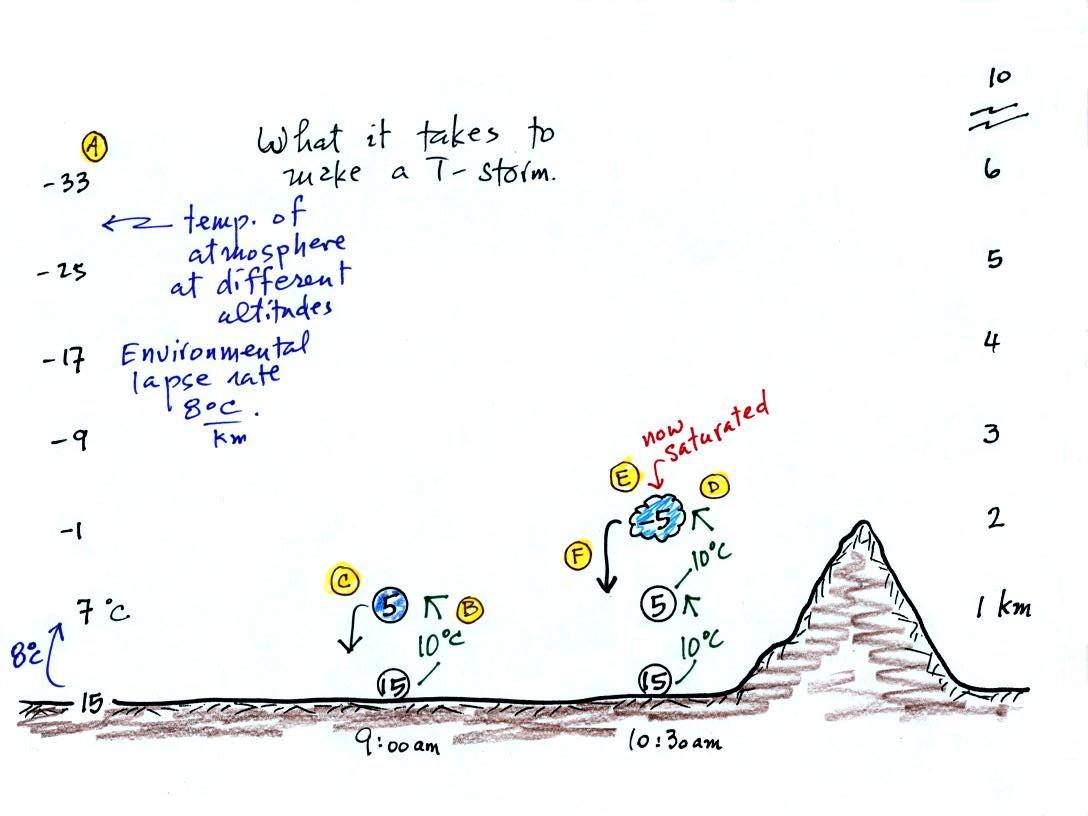
Refer back and forth between the lettered points in
the
figure
above and the commentary below.
The numbers in Column A
show the temperature of the air in the atmosphere at various altitudes
above the ground (note the altitude scale on the right edge of the
figure). On this particular day the air temperature was
decreasing at a rate of 8 C per kilometer. This rate of decrease
is referred to as the environmental lapse rate (lapse rate just means
rate of decrease with altitude). Temperature could
decrease more quickly than shown here or less rapidly.
Temperature in the atmosphere can even increase with increasing
altitude
(a temperature inversion).
At Point B, some of
the surface air is put into an imaginary container, a parcel.
Then a meterological process of some kind lifts the air to 1 km
altitude (in Arizona in the summer, sunlight heats the ground and air
in contact with the ground, the warm air becomes bouyant - that's
called free convection). The
rising air will expand and cool as it is
rising. Unsaturated (RH is less than 100%) air cools at a rate of
10 C per
kilometer. So the 15 C surface air will have a temperature of 5 C
once it arrives at 1 km altitude.
"Mother Nature" lifts the parcel to 1 km and "then lets go." At Point C note that
the air inside the parcel is slightly colder than the air outside (5 C
inside versus 7 C outside). The air inside the parcel will be
denser than the air outside and the parcel will sink back
to the
ground.
By 10:30 am the parcel is being lifted to 2 km as shown at Point D. It is still
cooling 10 C for every kilometer of altitude gain. At 2 km, at Point E the
air
has
cooled
to
its
dew
point
temperature
and
a
cloud has
formed. Notice at Point
F, the air in the parcel or in the cloud (-5 C) is still colder
and denser than the surrounding air (-1 C), so the air will sink back
to the ground and the cloud will disappear. Still no thunderstorm
at this point.
At noon, the air is lifted to 3
km. Because the
air
became saturated at 2 km, it will cool at a different rate
between 2 and
3 km altitude. It cools at a rate of 6 C/km instead of 10
C/km. The saturated air cools more slowly because release of
latent heat
during condensation offsets some of the cooling due to
expansion. The air that arrives at 3km, Point H, is again still
colder than the
surrounding air and will sink back down to the surface.
By 1:30 pm the air is getting high enough that it has become
neutrally
bouyant, it has the same temperature and density as the air around it
(-17 C inside and -17 C outside). This is called the level of
free convection, Point J in the figure.
If you can, somehow or another, lift air above the level of
free
convection it will find itself warmer and less dense than the
surrounding air as shown at Point K and will float upward to the top of
the troposphere on its own. This is really the
beginning of a thunderstorm. The thunderstorm will grow
upward
until it reaches very stable air at the bottom of the stratosphere.
This was
followed by a time lapse video tape of
actual thunderstorm formation and growth. I don't have a digital
version of that tape, so here is a
substitute time lapse of a day's worth of thunderstorm develop
The events leading up to the
initiation of a summer air mass
thunderstorm is
summarized in
the figure below. It takes
some
effort and often a good
part of the
day before a thunderstorm forms. The air must be lifted to just
above the
level of free convection (the dotted line at middle left in the
picture). Once air is lifted above the level of
free
convection it finds itself warmer and less dense that the air around it
and
floats upward on its own. I've tried to show
this with colors below. Cool colors below the level of free
convection because the air in the lifted parcel is colder and denser
than its surroundings. Warm colors above the dotted line indicate
parcel air that is
warmer and less dense than the surroudings. Once the parcel is
lifted above the level of free
convection it becomes bouyant; this is the
moment at
which the air mass thunderstorm begins.
Once a
thunderstorm develops it then goes through 3 stages.

In the
first stage you would only find updrafts inside the cloud (that's all
you need to know about this stage, you don't even need to remember its
name).

Once precipitation has formed and grown to a certain size, it will
begin to
fall and drag air downward with it. This is the beginning of the
mature
stage where you find both an updraft and a downdraft inside the
cloud.
The falling precipitation will also pull in dry air from outside the
thunderstorm (this is called entrainment). Precipitation will mix
with
this drier air and evaporate. The evaporation will strengthen the
downdraft
(the evaporation cools the air and makes it more
dense).
The thunderstorm is strongest in the mature stage. This is when
the
heaviest rain, strongest winds, and most of the lightning occur.
Eventually the downdraft spreads
horizontally throughout the inside of
the
cloud and begins to interfere with the updraft. This marks the
beginning of the end for this thunderstorm.

The
downdraft eventually fills the interior of the cloud. In this
dissipating stage you would only find weak downdrafts
throughout the cloud.
Note how the winds from one
thunderstorm can cause a region of
convergence on
one side of the original storm and can lead to the development of new
storms. Preexisting winds refers to winds that were blowing
before the
thunderstorm formed. Convergence between the prexisting and the
thunderstorm downdraft winds creates rising air that can initiate a new
thunderstorm.
The
picture below shows some of the features at the base of a thunderstorm.
The cold downdraft air spilling out of
a
thunderstorm hits the ground
and
begins to move outward from underneather
the
thunderstorm. The leading edge of this outward moving air is
called a
gust front. You can think of it as a dust front because the gust
front
winds often stir up a lot of dust here in the desert southwest (see
below).
The
gust
front in this picture (taken
near Winslow, Az) is moving from the right
to the
left. Visibility
in the dust cloud can drop
to near zero which
makes this
a serious
hazard to automobile traffic. Dust storms like this are
sometimes called "haboobs".
There's lots of video on YouTube of an impressive dust storm this
past summer. Here's an example from
Gilbert Arizona. Another from
South Mountain.

A
narrow intense downdraft is called a microburst. At the ground
microburst winds will sometimes reach 100 MPH (over a limited area);
most
tornadoes have winds of 100 MPH or less. Microburst winds can
damage
homes (especially mobile homes that aren't tied to the ground), uproot
trees,
and seem to blow over a line of electric power poles at some point
every summer
in Tucson.
Microbursts
are a serious threat to
aircraft
especially when they are close to the ground during landing or
takeoff.
An inattentive pilot encountering headwinds at Point 1 might cut back
on the
power. Very quickly the plane would lose the headwinds (Point 2)
and then
encounter tailwinds (Point 3). The plane might lose altitude so
quickly
that it would crash into the ground before corrective action could be
taken. Microburst associated wind shear was largely responsible
for the crash of Delta Airlines Flight 191 while landing at the Dallas
Fort Worth airport on Aug. 2, 1985 (click here to watch a
simulation of the final approach into the airport, I don't show it in
class because it contains some of the actual cockpit communications).
Falling rain could warn of a wet
microburst (see photo below). In other cases,
dangerous
dry microburst winds might be invisible (the virga,
evaporating
rain,
will
cool
the
air,
make
the
air
more
dense,
and
strengthen
the
downdraft
winds).

This is as far as we got in class on
Tuesday. There were just a couple of things
remaining and I have added them below. I'll go over these briefly
at the start of class on Thursday.
Just to hammer home the idea of
what a gust front might look like
I
showed another (the last) of my homemade videos (not shown in class
on Tuesday)

A
large
plastic
tank was filled
with water, the water represents air in the
atmosphere. Then a colored mixture of water and glycerin, which
is a
little denser than water, is poured into the tank. This
represents the
cold dense air in a thunderstorm downdraft. The colored liquid
sinks to
the bottom of the tank and then spreads out horizontally. In the
atmosphere the cold downdraft air hits the ground and spreads out
horizontally. These are the strong winds that can reach 100
MPH. The video is on VHS tape so I can't put it online (you
aren't missing much).
Here are three microburst videos from
YouTube (the
second two were shown in class).
The first
video shows a microburst from some distance away. The second video was
taken in the heavy rain and strong winds under a thunderstorm in the
microburst. You'll see a power pole snapped in half by the
microburst winds at about 2:26 in the video. Here's
a
third video
of a microburst that hit Princeton KS in July 2009. Someone
watching the storm estimated the winds were at least 90 MPH. Try
to imagine being caught outdoors during the last video, you would have
difficulty walking. And if there were any debris being blown
around by the winds you'd be at some risk of serious injury.
The
following
picture shows a
shelf
cloud (a thunderstorm cloud feature mentioned earlier in the semester
when we were learning to name clouds).
Warm
moist
air
if lifted by the cold air behind the gust front which is
moving from left
to right in this picture. The shelf cloud is very
close to
the
ground, so
the warm air must have been very
moist because it didn't have to rise and cool much before it became
saturated and a
cloud
formed. Here are a couple of pretty good videos (Grand Haven, MI
and Massillon, OH)
We'll spend most of the day on tornadoes in class on Thursday
though we will
learn a little bit more about thunderstorms (tornadic thunderstorms) in
the process.













